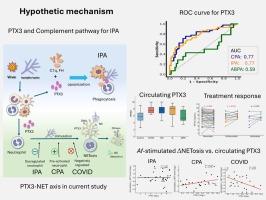Monitoring treatment response using serial PTX3 levels in chronic and invasive pulmonary aspergillosis
IF 2.9
3区 医学
Q2 MEDICAL LABORATORY TECHNOLOGY
引用次数: 0
Abstract
Background
Pentraxin 3 (PTX3) is an innate immune biomarker involved in host defense against Aspergillus species. While elevated PTX3 levels have been observed in various infection states, its utility in monitoring treatment response in pulmonary aspergillosis remains underexplored.
Methods
We assessed serial PTX3 levels in total 216 patients with chronic pulmonary aspergillosis (CPA, n = 48) and invasive pulmonary aspergillosis (IPA, n = 48) before and after antifungal therapy. Comparative groups included controls (n = 69), COVID-19 patients (n = 36), and allergic bronchopulmonary aspergillosis (ABPA, n = 15). Serum PTX3 concentrations were measured by ELISA and analyzed in relation to treatment response. Neutrophil extracellular trap (NET) formation under various stimuli was evaluated and correlated with PTX3 levels to explore immune activation patterns.
Results
PTX3 levels were significantly elevated in CPA and IPA compared to controls. Among patients with serial samples, PTX3 levels declined significantly in favorable responders (from 299.0 [119.5–477.0] to 138.3 [80.9–386.1] pg/mL; p < 0.05), but increased in unfavorable responders (from 177.1 [117.8–318.8] to 243.0 [169.5–488.4] pg/mL; p < 0.05). PTX3 changes correlated with disease course and NET responses in a phenotype-specific manner.
Conclusion
Serial measurement of PTX3 may serve as a useful biomarker for monitoring treatment response in pulmonary aspergillosis. PTX3 dynamics reflect underlying immune activity and may aid in identifying disease progression or relapse.

慢性和侵袭性肺曲霉病患者PTX3连续水平监测治疗反应。
背景:penttraxin 3 (PTX3)是一种先天免疫生物标志物,参与宿主对曲霉的防御。虽然在各种感染状态中观察到PTX3水平升高,但其在监测肺曲霉病治疗反应中的效用仍未得到充分探讨。方法:对216例慢性肺曲霉病(CPA, n = 48)和侵袭性肺曲霉病(IPA, n = 48)患者抗真菌治疗前后的PTX3水平进行系列检测。对照组包括对照组(n = 69)、COVID-19患者(n = 36)和过敏性支气管肺曲菌病(n = 15)。采用ELISA法测定血清PTX3浓度,并分析其与治疗反应的关系。评估各种刺激下中性粒细胞胞外陷阱(NET)的形成,并与PTX3水平相关,以探索免疫激活模式。结果:与对照组相比,CPA和IPA患者PTX3水平明显升高。在系列样本患者中,PTX3水平在有利应答者中显著下降(从299.0[119.5-477.0]降至138.3 [80.9-386.1]pg/mL; p 结论:PTX3的系列测量可作为监测肺曲霉病治疗反应的有用生物标志物。PTX3动态反映潜在的免疫活动,可能有助于识别疾病进展或复发。
本文章由计算机程序翻译,如有差异,请以英文原文为准。
求助全文
约1分钟内获得全文
求助全文
来源期刊

Clinica Chimica Acta
医学-医学实验技术
CiteScore
10.10
自引率
2.00%
发文量
1268
审稿时长
23 days
期刊介绍:
The Official Journal of the International Federation of Clinical Chemistry and Laboratory Medicine (IFCC)
Clinica Chimica Acta is a high-quality journal which publishes original Research Communications in the field of clinical chemistry and laboratory medicine, defined as the diagnostic application of chemistry, biochemistry, immunochemistry, biochemical aspects of hematology, toxicology, and molecular biology to the study of human disease in body fluids and cells.
The objective of the journal is to publish novel information leading to a better understanding of biological mechanisms of human diseases, their prevention, diagnosis, and patient management. Reports of an applied clinical character are also welcome. Papers concerned with normal metabolic processes or with constituents of normal cells or body fluids, such as reports of experimental or clinical studies in animals, are only considered when they are clearly and directly relevant to human disease. Evaluation of commercial products have a low priority for publication, unless they are novel or represent a technological breakthrough. Studies dealing with effects of drugs and natural products and studies dealing with the redox status in various diseases are not within the journal''s scope. Development and evaluation of novel analytical methodologies where applicable to diagnostic clinical chemistry and laboratory medicine, including point-of-care testing, and topics on laboratory management and informatics will also be considered. Studies focused on emerging diagnostic technologies and (big) data analysis procedures including digitalization, mobile Health, and artificial Intelligence applied to Laboratory Medicine are also of interest.
 求助内容:
求助内容: 应助结果提醒方式:
应助结果提醒方式:


